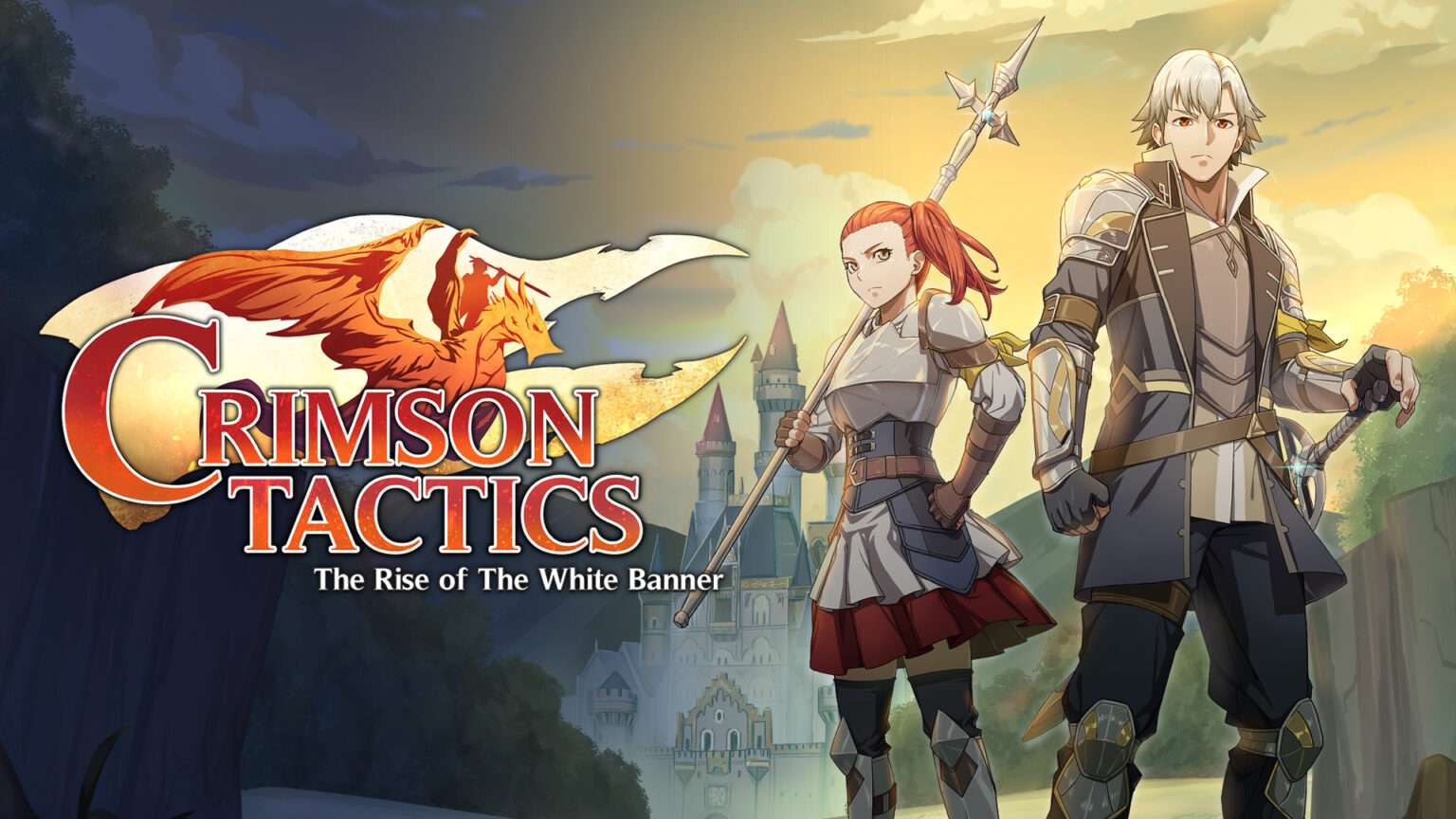To choose a tactical RPG as your first major project as a new team seems like a daunting task. These games depend on delicate systems to keep gameplay balanced and rely on a rich story to keep players engaged throughout the many, often long, battles ahead. Taking inspiration from earlier giants like Final Fantasy Tactics and Tactics Ogre forms a solid foundation, but can Black March Studios use these examples to build something greater, or was this a tactical blunder?
How tough do you want it?
When starting a new game you’re first asked if you’d like to play on either ‘tactical’ or ‘strategic’ mode. Tactical mode offers a more streamlined experience, by lowering the amount of combatants and increasing movement range. This does not necessarily alter the difficulty, but it does change the dynamics of the game a little. Seeing that long battles are an often heard complaint in the genre, I think it’s a clever addition.
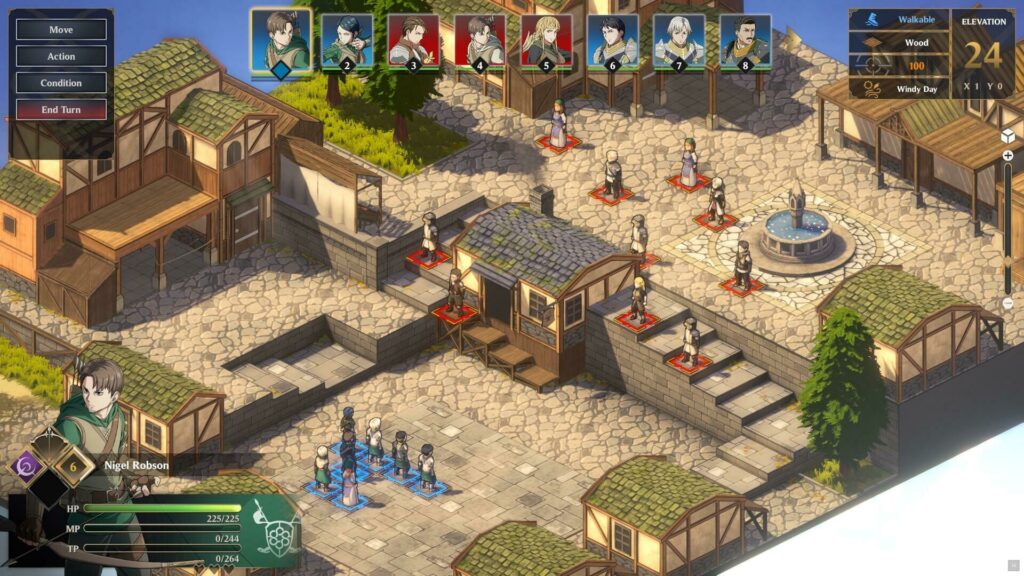
Next are the difficulty options, of which there are 5 or you can opt for the dynamic setting which will scale up and down based on your performance, which is probably the most rewarding option. For some reason the game does not allow you to change the challenge after starting, which did end up ruining the experience for me somewhat. The difficulty of the game, as is often the case in this genre, is rather frontloaded. My ‘normal’ game ended up being a bit of a joke. By the time I realized, I didn’t really want to start all over again however.
Familiar tactics with middling accuracy for innovation
Once the battles start, fans of the genre will immediately feel right at home. At the start you can field up to 12 party members to do battle on a grid based field. Turn order is determined by character stats and equipment weight and each turn you can move and take an action. Proper positioning and using the right skills at the right time are the road to success, though of course you’ll also want to throw and occasional prayer to lady Fortuna on those just not 100% rolls.
Characters can be assigned (familiar) classes, which determines the type of equipment they can use. After battles participants are awarded EXP and SP. The latter can be used to unlock new skills. Of course you can also change classes to mix and match skills, as these need to be equipped to skill slots. Class changing requires a class mark, an item that drops from enemies of the corresponding class. So you’re not completely free to switch things up, but that might be for the better as stat growth is tied to the class. So if you want a powerful spellcaster, you’d best keep them to the high INT classes.
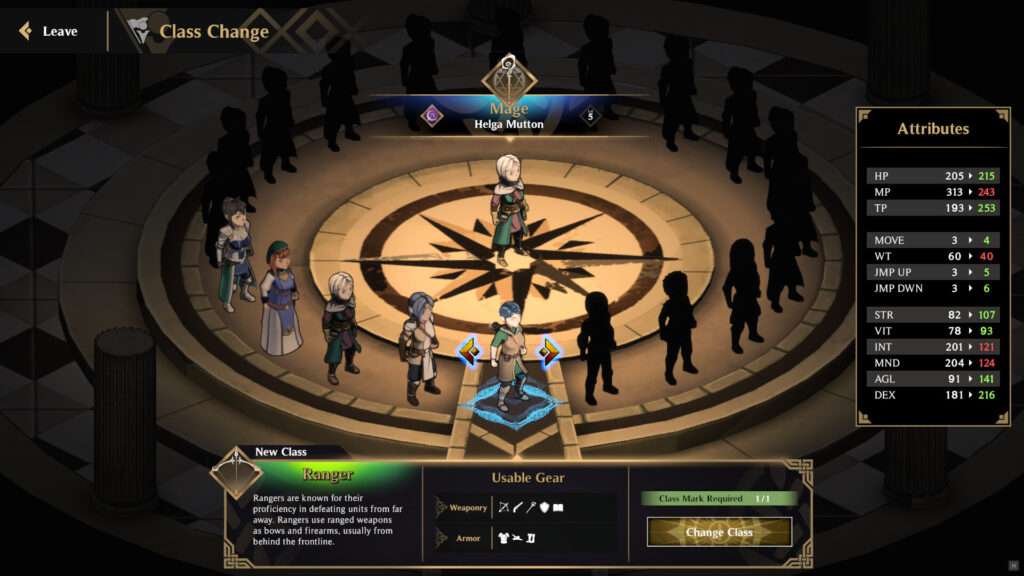
Something the game does well, is build momentum. At the start of a skirmish everyone starts with 0 MP and TP, needed for spells and abilities. As a turn comes up, they charge up a little. This gives you some strategy on using a weaker ability early or a more potent one later. More importantly, you’ll never feel like it’s a limited resource and encourages skill use.
Speaking of spells, an interesting idea here is that everyone with an elemental affinity is able to cast all spells of that element. By default everyone but the mage, who can use all elements, has one spell slot. Spells can be learned through a codex of that spell, which can be either won from battle or bought in shops. So you could have you frontliners use a defensive boost through a spell on their first turn for example or use it as a long distance option.
This versatility is also found in the weapons. Apart from differences in damage and weight, different weapons are also varied in attack patterns. Some hit hard in only one of four directions, others penetrate through two squares, lances can also attack diagonally and the big boys will whack three targets at once. What’s really cool is that abilities are tied to your weapon’s pattern, so you could also debuff three targets at once! Or just the one and your two allies who you’ve previously placed besides it… oops.
There’s also a less successful mounts system. A character can be assigned a horse or, in one instance, a dragon. Unfortunately these have some serious drawbacks. They take up four spaces on the map, limiting where they can go and also make them easy pickings from all sides. Worst still, is that they take up a deployment slot, so you’ll have to offer up a whole turn someone could have been doing damage. And what do they offer? HP, they are basically meat shields! The dragon does have one unique ability, that is rather situational and underwhelming. They also offer a movement of five, which is more than most classes… yeah, some move just as far.
The monotony of war
The main issue for combat is that the game rarely if ever uses the capitalizes of its own mechanics. It has functionality to create interesting strategic setups, but special tiles, weather effects or height differences are never used to build interesting setups. There’s no special obstacles to overcome, ground to defend or any special objectives for that matter. Some maps are also really small, making a lot of the fights feel similar as simple skirmishes.
You either have to kill all enemies, or one specific ‘boss’ unit. And these missions are the most frustrating. Sometimes the person will just charge straight into your army on their first turn and a battle can be over on the first turn, it’s quite ridiculous. That is, if they are meant to die. Sometimes these guys are scripted to ‘escape’. This makes them invincible and they’ll move to the edge of the map, all the while the battle continues like normal. These instances feel particularly unsatisfying. The further you go in the game, the less inspired battle and battlefield design becomes in general.
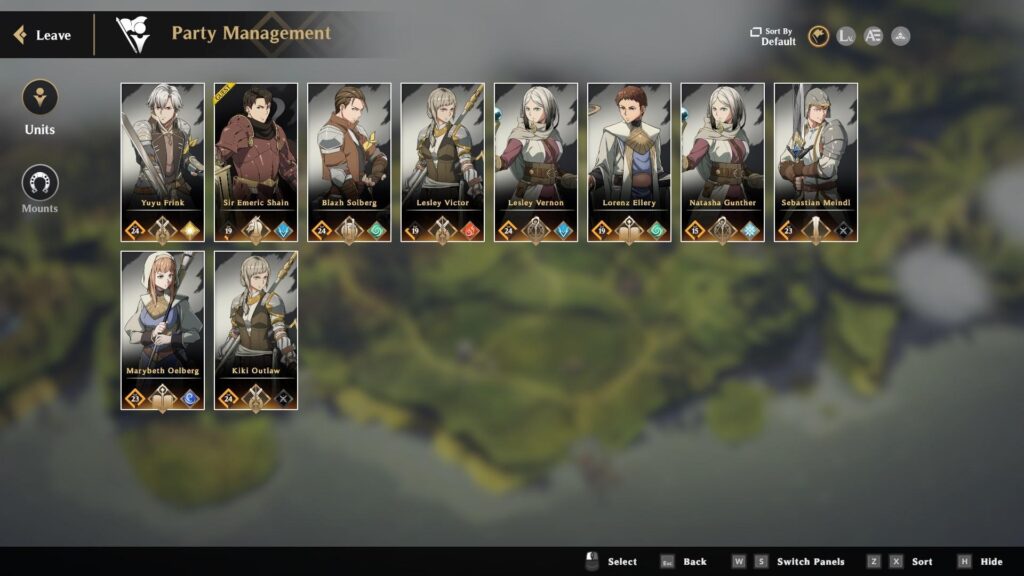
The game actually starts out strong. It has a captivating prologue, which sees you on a mission to usurp the throne of Wendalle. There’s an alliance with an, obviously evil, empire in play and it all leads to full scale civil war. The setting is further explained through an intro video that makes one think they’re in for lots of political intrigue and backstabbing. Then the main game starts and all of that is soon forgotten as the main games scales it back to take place within a single duchy within the kingdom.
Here we take on the role of a knight recruit in the employ of Duke Arsenio Duran. Our hero will soon finds himself at odds with the way his fellow knights handle business and before we know it his morality has pushed him towards joining the titular White Banner rebel group within the duchy. The game takes on an almost episodic nature, where you get send somewhere to go fetch someone, or something, for the war effort and the main plot, let alone the overarching conflict, is rarely brought up again in a meaningful way.
Don’t get me wrong, there will be backstabbing. The game actually loves to delve into some dark and truly despicable actions, but the game misses the mark when it comes to clever writing. Characters are one dimensional and there is next to no growth. Bad guys are comically evil and the few twists the game offers are so obvious in advance that you end up being surprised they weren’t a red herring.
Choice is an illusion
In the beginning parts you actually get a few choices on how to act, giving the impression of a morality system and potential consequences. But unfortunately, this is not the case, they change nothing. With a sole exception at the end of the game where you get to unlock one of two classes, which would make the third whole choice by that point. What’s kind of baffling is that often the party has disagreements on how to do things and the way it’s presented feels like you need to make the final call. But the main character just decides for you and this feels very inconsistent with the start of the game.
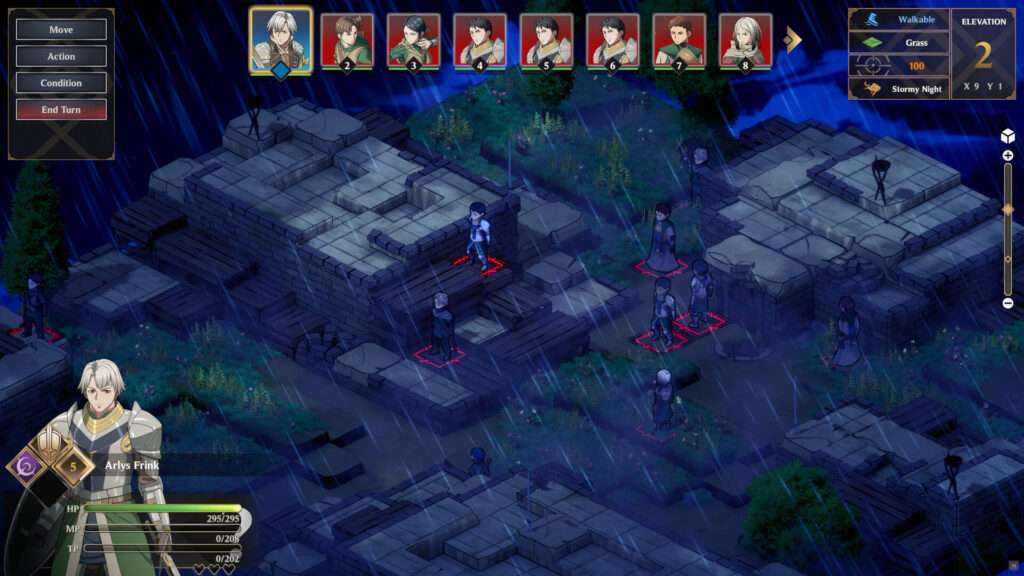
Something that did impress me and help bring characters to life are the graphics. Areas are pretty diverse, making some nice backdrops for the 3D models that have thick outlines, giving them an almost cell shaded look. These also animate quite nicely. Seeing someone laying a comforting hand on a comrade’s shoulder says more than any script could ever do.
The UI is mostly fine as well. Information is easy to find on the turn order, accuracy and damage predictions and texts have good contrast and is easy to read. Unfortunately, there are no scaling options though, and the text is rather small. Another thing that I would love to see improved, is the distinctiveness of classes. They can all look a bit too similar.
Out of battle management
Outside of battles the UI takes a bit of a hit, especially when it comes to navigating the different shops. There is a simple crafting system and you can buy and sell items in the shops. These are separate screens and you up going a back and forth between menu’s trying to find the info you need. Some improvements would really help here. For example icons to show if a craftable item is also sold in the shop and visa-verse. Or buying materials straight from the crafting window. And why can I see how many potions I already own when crafting them, but not when I’m buying them?
In towns you can also replenish your troops via the guild. There is permadeath, although it will be rare to encounter this. When someone goes down, they will ‘die’ in three turns without being revived. Every generic character has 3 lives though, so they can last quite long regardless. Story characters have infinite lives… which makes them great frontliners to throw into the grinder. You still want to use the guilds often though, as often you’ll find troops some levels higher than your own and it won’t take long before you start swimming in gold.
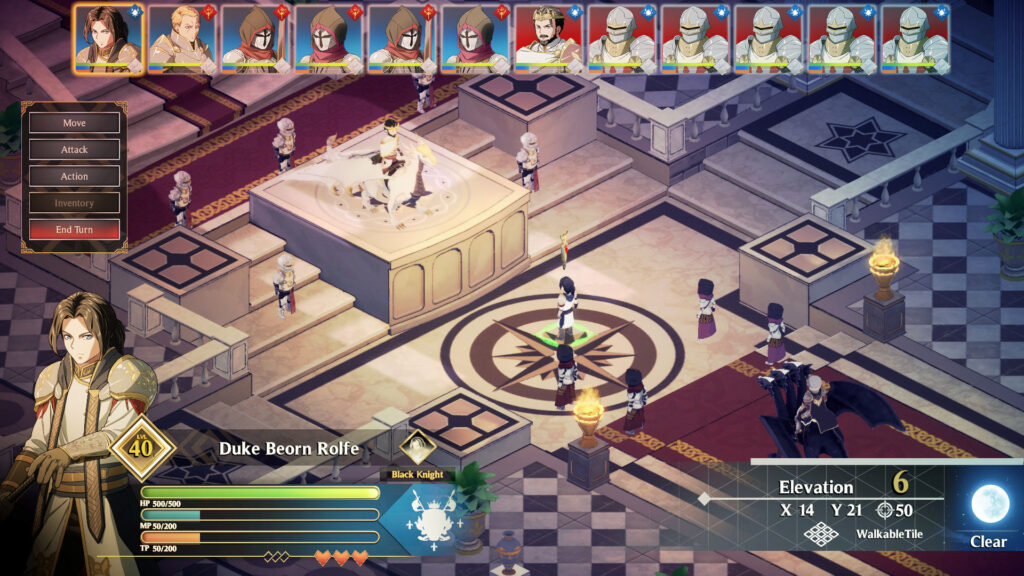
Once you start to multiclass, you might want to be more protective of your assets. New units are always a single class with its associated skills. Heck, I don’t think I’ve even run into a single enemy using skills from multiple classes. Another way to get an edge is through the tarot cards that enemies drop. These grand permanent stat increases. They feel way more common than they should be and before long you’ll be handing these out like candies.
Commanding troops is no easy job
And how are the actual controls? Well, the good news is that you can opt for either keyboard and mouse or gamepad. The bad news is that neither feel particularly great. On controllers the cursor is too sensitive for my liking and it does some odd things with having to switch between menu selection and cursor overlay. Keyboard and mouse just don’t fit this kind of game very well in in my opinion. It’s odd to me that they didn’t look at how these games are typically played and started from there. It’s only at the last patch that controller support was even added. What’s even more baffling is that the keybinds cannot be changed. It’s functional, just not very intuitive and could do with some customization.
Luckily, you don’t have to babysit everyone however, as you can assign AI archetypes. These are quite capable, to the point where they can win battles on their own. Rarely have I seen them waste a turn. It can be nice to be able to set a few troops to auto in order to speed things up, which is further helped by the 3 different speed settings the game offers. A much appreciated feature, as the normal speed can be a bit sluggish.
So… what went wrong?
In conclusion, I have mixed feelings on this game as it seems to have some good ideas and I love the design of the game. But the more I played, the more it felt undercooked. Perhaps this has something to do with the very short early access period of just over a month before launching. During this time the devs already added features and fixed bugs, but this to me clearly wasn’t enough time in the oven.
The developer suddenly decided to scale back, for a lower price for the final product. Indie game development takes a lot of skill and dedication and it can be a brutal market to operate in, so I could empathize with altering course to a degree. That being said, the game still costs €30 and it just doesn’t feel finished and very rushed towards the end. So much so that the game just… stops. There’s no real climax that ties back into the start of the game. It offers around 25 to 30 hours of gameplay, but apart from a very solid start, it mostly feels uninspired.
The developer has stated that the story will continue in the next installment, basically splitting the game in two. They will work on fixing the bugs that are found within this game. For now, we only have this game as their calling card and I’m afraid this was a rather poor first impression. My advice would be to wait and see how this series develops. If they manage to pick themselves up, I really believe this team can enrich the genre, but this first installment on its own, does not reflect that.
Pros:
+Appealing visual design
+Great and promising start
+Dynamic difficulty system
Cons
-Few ideas fully realized
-Story quickly loses traction
-Rushed and unfinished


